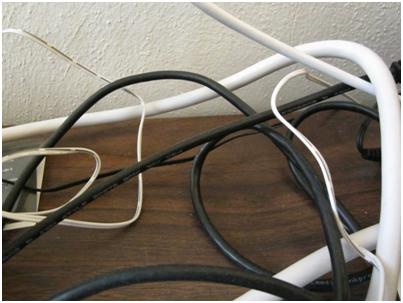About Research
Entangled Polymer Dynamics
What is entanglement? Imagine that you have power cords for appliances connected to the same power strip, and you leave them lying under your desk (like the picture underneath), unorganized and entangled. Today you wanted to put away one of the appliances to save space for your desk, so you unplugged that from the power strip. You then tried to pull the cord hard but it was stuck in the mess of cords.

Why was it so difficult to pull it out? That is because of entanglement. Another way of saying is that because the cords exclude space from each other. If the cords are made of things that can pass through each other, then we should be able to get individual cords out very easily. (That may sound impossible – but maybe someday we can efficiently transmit power with microwave or lasers!)
Therefore, we know that the excluded volume effect has a drastic impact on the possible motion of the cords. We can then continue to explore the factors affecting entanglement such as length, flexibility, density and so on. We can go on and think of other examples of entanglement such as spaghetti, traffic jam and of course, polymer. So what exactly do we do to study entanglement?
In the laboratory, we investigate entanglement in another dimension (around 10 µm in length). These miniature cords are called actin, a biopolymer that can be found in the cells inside you and me. They are important in carrying out cell functions and specifically crucial for cell movements.
I am currently working on the dynamics of entangled actin - by labeling these actin filaments with fluorophores we can directly look at individual actin filaments in a pool of invisible, unlabeled ones. By tracking the movement of these actin filaments, we can gain understanding on the fundamental questions about polymer entanglement.
For example, the actin filaments are constantly jiggled by thermal energy, is it easier to jiggle in longitudinal direction than in transverse direction? Does it jiggle as how people anticipated? We can also consider the effect of shearing, surface pinning, or filament length on the dynamics of entangled polymer.
Beyond looking for answer to above questions, we also hope to get insight in entanglement from tracking these actin filaments in the microscope.
About Boyce
Technical: In my undergraduate research I worked on optics, ceramic thin film, cryogenics and vacuum. My formal education in Physics really helped me in break equations or complicated pictures into edible chunks. Also, I always remembered the words from Richard Feynman, that “knowing something and knowing the name of something is different”.
Personal: I am from Hong Kong, a dense city with interesting mix of skyscrapers with country parks, eastern cultures with western cultures. In leisure time I play guitar and I enjoy listening to music a lot. I also produce music from time to time. Though I am not a very good player - now I also like playing basketball.

